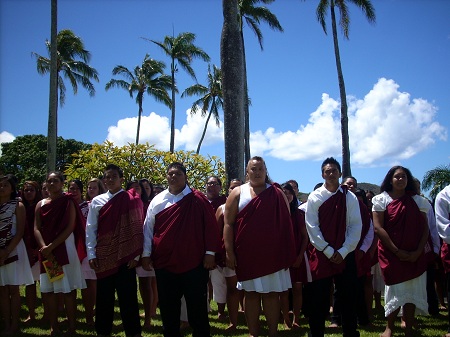September 2nd is the day that the last ruling monarch of Hawai‘i was born and I was invited by the trustees of the Queen Lili‘uokalani Trust to join them at a ceremony honoring her birthday at Mauna ʻAla, the Royal Mausoleum where members of both the Kamehameha and Kalākaua dynasties are buried.
The last queen was the successor to her brother, David Kalākaua, and the last ruler of the islands. Born in a grass hut in 1838, Lili‘uokalani was a fervent patriot who struggled for the restoration of her land and the rights of her people for most of her life. She died in 1917, nearly two decades after America had annexed her independent Kingdom of Hawai‘i.

At the offices of the Lili'uokalani Trust, a poster depicting the late queen is draped with a lei tribute.
Yesterday morning, we headed up towards the mountains, along Nuʻuanu Avenue to pay our respects to her. It was sprinkling when we arrived, but the clouds soon parted and the air grew steamy. The white-clad members of the Royal Hawaiian Band, one of the oldest continually performing municipal bands in the U.S., began to play.

The birthday commemoration for Queen Lili'uokalani was held at Mauna 'Ala, the Royal Mausoleum, in the hills above downtown Honolulu.
The Daughters and Sons of Hawaiian Warriors, along with descendants of the Hawaiian royal family, were there. So were some of the Hawaiian children who were beneficiaries of the trust that Lili‘uokalani set up in 1909. (For more information on the history of the trust, take a look at a fascinating article in the Hawaii Bar Journal from May of 2009 entitled “The Queen’s Estate” by Samuel P. King, Walter M. Heen, and Randall W. Roth.)
The Queen Lili‘uokalani Children’s Center, the operating unit of the trust, organized the program at Mauna ʻAla. According to Trustee Claire Assam, last year the trust spent $14.7 million to help care for 1,441 orphan children and 9,531 destitute children. All of its revenues come from its real estate holdings, which include 6,330 acres of land, mostly on Hawai‘i Island (also called the Big Island).

High school students who chanted for the late queen. Beneficiaries of the Lili'uokalani Trust also attended the ceremony.
I brought a lei of crown flowers – the delicate, lavender-colored blooms that were the queen’s favorite – to place in her crypt, after all the dignitaries had made their way down into the tomb and back with their offerings. I walked down the steps, took off my sandals, and entered the cool, dark space, which is normally gated off to the public. It was the closest I had gotten to her — at least physically — in the three years I’ve been working on The Lost Kingdom.
Then I said a prayer, reflecting on what I’d learned from the past few years of trying to understand her through her letters and diaries, and through the numerous historical documents and books written about 19th-century Hawai’i. The reverence she was accorded on this day was its own eloquent testament to her life and legacy.
I wasn’t the only one who found it moving. Honolulu’s acting mayor, Kirk W. Caldwell, also attended the service. He remarked, “It’s a reflection on what the ali‘i [the Hawaiian royals] have given this community – the trusts, the Queen’s Hospital, which is the best hospital in the state, the Kap‘iolani Women and Children’s Hospital where almost everyone was born…” “adding “it was a little bit chicken skin for me as I went down into the vault.”
